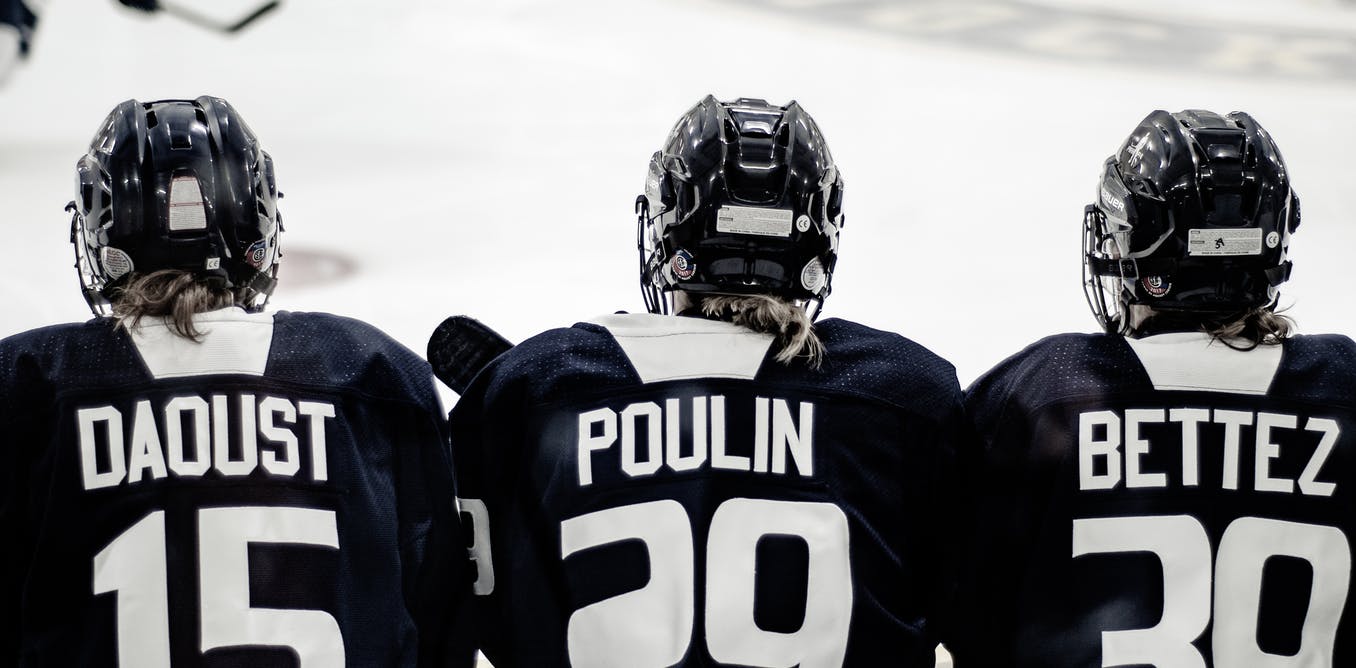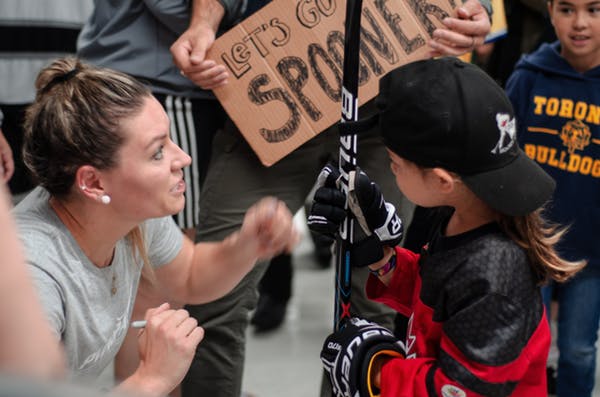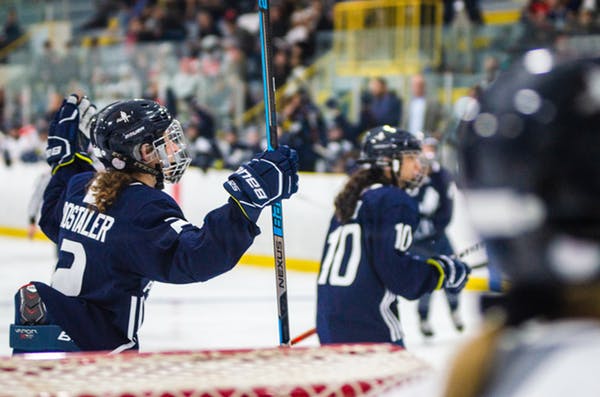By Julie Stevens, Michele K. Donnelly and Simon Black/The Conversation
The Dream Gap Tour of elite hockey players put the women’s game back in the news this fall. Some of the world’s best players – including more than 35 Olympians – played in the four-team exhibition tournament that traveled to Toronto, Chicago and Hudson, N.H.
A few months earlier, professional women’s hockey seemed to be in crisis. The six-team Canadian Women’s Hockey League (CWHL) had folded in May due in part to financial issues, leaving one professional women’s hockey league in North America – the U.S.-based National Women’s Hockey League (NWHL). Later that month, more than 200 players launched a boycott of that league over demands for better pay and working conditions.
 Former Les Canadiennes de Montréal players Mélodie Daoust, Marie-Philip Poulin and Ann-Sophie Bettez wait for their shift at a Dream Gap Tour game in Toronto/Courtney, Flickr
Former Les Canadiennes de Montréal players Mélodie Daoust, Marie-Philip Poulin and Ann-Sophie Bettez wait for their shift at a Dream Gap Tour game in Toronto/Courtney, Flickr
Ultimately, the upheaval led to the creation of the Dream Gap Tour and the Professional Women’s Hockey Players’ Association (PWHPA).
Tour supporters, including the National Hockey League Players Association (NHLPA) and Unifor (Canada’s largest private-sector union), hope the strategy will lead to more and better paid opportunities for women to play, and the creation of a “single, viable women’s professional league in North America.”
The mission is to close “the gap between what boys and girls can aspire to achieve” in professional hockey. But will it work?
The Growth Of Women’s Hockey
Many of the advances in women’s hockey since the 1970s are due to collective action on the part of advocates.
Previous research on girls’ minor hockey associations in Ontario found that when leaders within a local community work together, new girls’ teams, leagues and organizations were created. The new opportunities came from women’s hockey leaders assuming greater authority over the governing hockey bodies that managed how girls and women play the game.
 Former Toronto Furies player Natalie Spooner signs an autograph for a young fan/Courtney
Former Toronto Furies player Natalie Spooner signs an autograph for a young fan/Courtney
This advocate-led approach also drove growth at the provincial and national level. Rhonda Leeman Taylor’s memoir, Offside: Challenges Faced by Women in Hockey, tells of how women – and men – stood together to advance the women’s game. Their major accomplishments included the formation the Ontario Women’s Hockey Association in 1975 and the reinstatement of a senior women’s Canadian championship in 1982.
Unionized Hockey Players
On the men’s side, a professional players’ union didn’t form until many years after the National Hockey League was established. NHL players faced a difficult time when trying to mobilize as a bargaining unit in the late 1950s, and the nascent union was ultimately crushed by team owners.
Only during the 1967-68 season did players successfully establish the NHLPA, allowing them put a check on the power of owners and lift salaries and working conditions through collective bargaining.
In contrast, the women organized the PWHPA first, with the aim of creating better opportunities. While some women currently play in the NWHL, that league has been criticized for failing to invest in the women’s game and pay players a living wage. Some professional women hockey players earn as little as $2,000 and have no health insurance.
In this case, labor, in the form of the PWHPA, is trying to direct the professional women’s hockey industry rather than respond to it. The Dream Gap Tour is a way for these advocates, including players, to show potential investors the type of product they envision for the professional women’s game in North America.
 Former Calgary Infernos player Laura Dostaler played on Team Johnston during the Dream Gap Tour/Courtney
Former Calgary Infernos player Laura Dostaler played on Team Johnston during the Dream Gap Tour/Courtney
The PWHPA is clear that its advocacy is not limited to the women playing hockey today. Its members are willing to make sacrifices (such as sitting out the 2019-20 season) to focus on the future of the game.
Kendall Coyne Schofield, the 2018 Olympic gold medalist and NWHL veteran, says “We are fortunate to be ambassadors of this beautiful game, and it’s our responsibility to make sure the next generation of players have more opportunities than we had. It’s time to stand together and work to create a viable league that will allow us to enjoy the benefits of our hard work.”
The strategy is bold but its success is uncertain, not least because it depends upon unbreakable unity among the players.
Will Solidarity Stick?
The success of the PWHPA hinges on three factors.
First, the Dream Gap Tour must show potential investors that a women’s professional league is a viable and profitable venture. Adidas, Dunkin’ and Tim Hortons sponsored the tour, and the arena was packed in Toronto for the first games. That success continued with sold-out games through the final weekend in Chicago.
Second, the PWHPA needs the bargaining power to make the NWHL bend to its demands, including a commitment to invest in expanding and marketing the women’s game.
And finally, as in any labor struggle, worker solidarity is a must. If, despite the success of the Dream Gap Tour, PWHPA players seek employment in the NWHL or in Europe, or leave the sport altogether, the chances of a new league forming are slim at best.
Not all women’s hockey players and advocates support the PWHPA’s approach. The five-team NWHL started its 2019-20 season on Oct. 5, and commissioner Dani Rylan said that “It’s definitely disappointing, to say the least, when the people that you built a business for, or a platform for, feel that destroying that business is the best way forward.”
Notably, Rylan also said player salaries have increased 26 per cent over the previous season, and that the league has agreed to a 50-50 split of sponsorship and media rights with the players. Arguably, the collective action of the PWPHA has influenced these decisions.
Let’s hope that the spotlight created by the Dream Gap Tour will continue to shine brightly. The sustainability of high caliber women’s hockey talent depends upon having the opportunity to earn a living while playing the game.
Julie Stevens is an associate professor of sport management and director of the Centre for Sport Capacity at Brock University. Michele K. Donnelly is an assistant professor in the sports management at Brock. Simon Black is an assistant professor of labor studies at Brock. This article is republished from The Conversation under a Creative Commons license.
–
Comments welcome.
Posted on October 29, 2019


